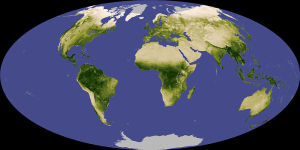
As natural climatic shocks strike the world over, both historically and recently, the human reaction has followed an old pattern. Over and over again, according to a new study, disaster management efforts related to food shortages caused by climate shocks result in returning the conditions back to the way they were before the shortage, rather than addressing root causes or vulnerabilities.
“Exposures to climate challenges and other environmental risks are not the sole causes of disasters,” says Margaret Nelson, an ASU President’s Professor in the School of Human Evolution and Social Change. “People have unintentionally built vulnerabilities through decisions and actions in social, political and economic realms.”
Nelson made the comment at the annual meeting of the American Association for the Advancement of Science in Chicago on February 16 as part of a team of four Arizona State University archaeologists. They are researching this as part of an international team examining how people can be most resilient to climate change when it comes to food security.
The research team used long-term archaeological and historical data from the North Atlantic Islands and the U.S. Southwest to form the basis of their understanding of changing dynamics in these areas. Each case in their study included information on evolving social, political and economic conditions over centuries, as well as climate data.
The extended timeframe and global scope allowed them to observe changes in the context of vulnerabilities and climate challenges on a broad scale. “The pattern is so consistent across different regions of the world experiencing substantially different climate shocks, that the role of vulnerability cannot be ignored,” she added.
Their findings support the argument for focusing on reducing vulnerabilities to climate shocks to boost resilience, which will ultimately lead to fewer required recovery efforts when crises occur.
Other ASU archaeologists involved in the study are professors Keith Kintigh, Michelle Hegmon and Kate Spielmann, all of the School of Human Evolution and Social Change in the College of Liberal Arts and Sciences.
______________________________
Source: Adapted and edited from a Arizona State University press release.
Cover Photo, Top Left: World globe map, Wikimedia Commons
_______________________________________________________________________________________________________________________
Read about the most fascinating discoveries with a premium subscription to Popular Archaeology Magazine. Find out what Popular Archaeology Magazine is all about. AND MORE:
 On the go? Purchase the mobile version of the current issue of Popular Archaeology Magazine here for only $2.99.
On the go? Purchase the mobile version of the current issue of Popular Archaeology Magazine here for only $2.99.
And, Popular Archaeology’s annual Discovery edition is a selection of the best stories published in Popular Archaeology Magazine in past issues, with an emphasis on some of the most significant, groundbreaking, or fascinating discoveries in the fields of archaeology and paleoanthropology and related fields. At least some of the articles have been updated or revised specifically for the Discovery edition. We can confidently say that there is no other single issue of an archaeology-related magazine, paper print or online, that contains as much major feature article content as this one. The latest issue, volume 2, has just been released. Go to the Discovery edition page for more information.
Subscription Price: A very affordable $5.75 for those who are not already premium subscribers of Popular Archaeology Magazine (It is FREE for premium subscribers to Popular Archaeology). Premium subscribers should email [email protected] and request the special coupon code. Or, for the e-Book version, it can be purchased for only $3.99 at Amazon.com.





